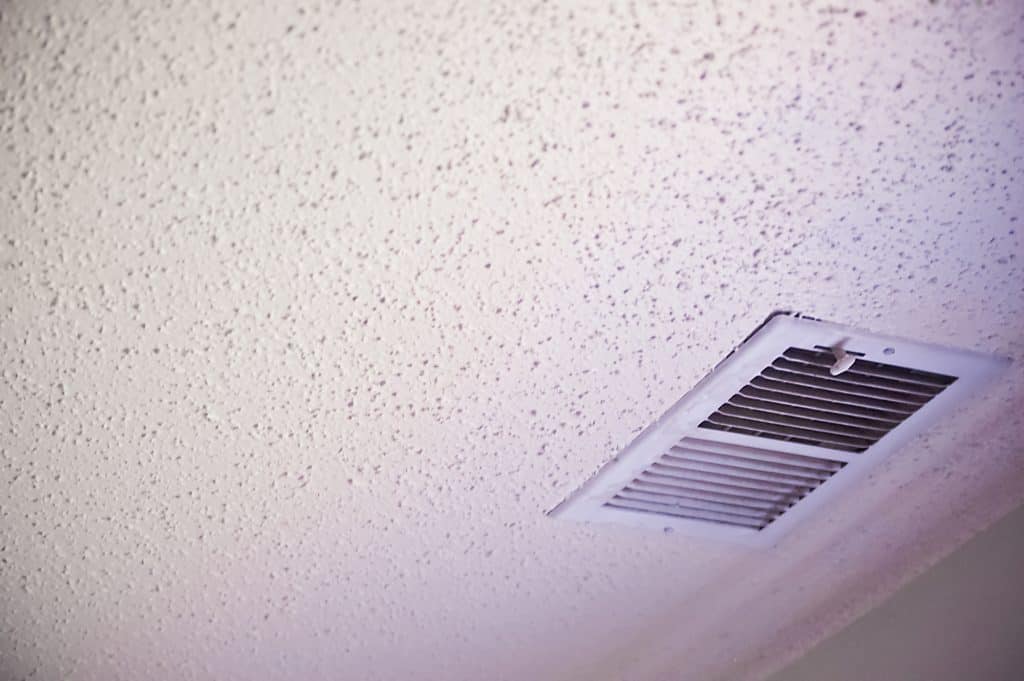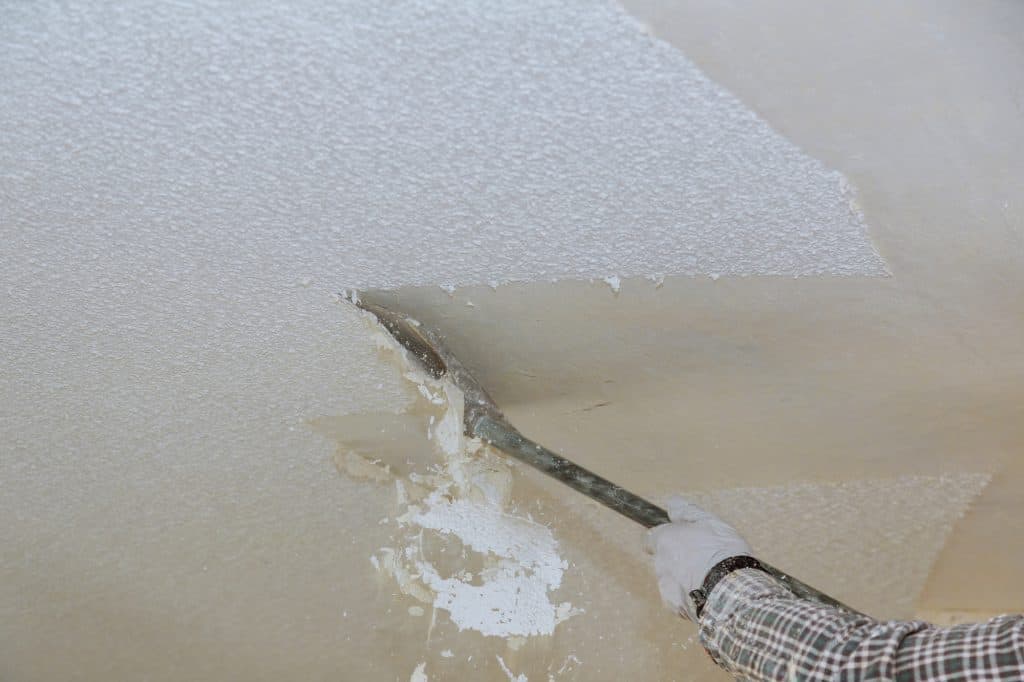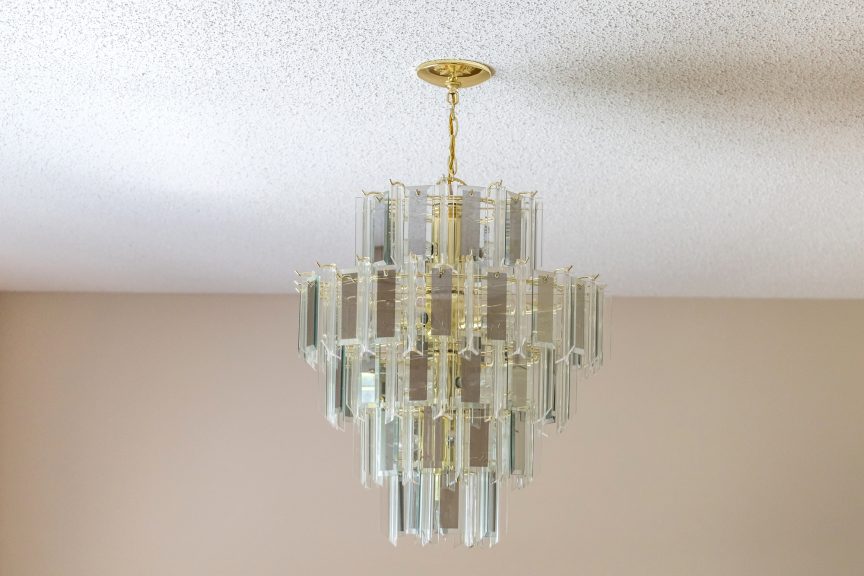Giovanni Valle is a licensed architect and LEED-accredited professional and is certified by the National Council of Architectural Registration Boards (NCARB). He is the author and managing editor of various digital publications, including BuilderSpace, Your Own Architect, and Interiors Place.
The average US home has a popcorn ceiling texture to it. And while plenty of modern homes feature smooth ceilings, textured alternatives continue to be far more commonplace.
Not all ceilings need to be textured. Flat, smooth ceilings can be as durable and attractive as textured ones. The primary reason why many residences have textured ceilings is cost. Popcorn ceilings are cheaper to install and can hide many construction flaws, resulting in lower overall costs.
In this article, I will explore why ceilings are textured and what benefits texturing might provide. I’ll also discuss the advantages of having a smooth ceiling texture and transitioning from textured ceilings to smooth ones.
Common Reasons Ceilings Are Textured
There are a handful of reasons why a contractor or homeowner might apply texture to their ceilings. Below are some of the common reasons ceilings are textured:
Textured Ceilings Can Cover Flaws – As devious as it might sound, some contractors choose to install textured ceilings because they are an easy way to hide construction flaws. Landlords might also opt for textured ceilings to hide signs of damage, such as cracks, water stains, or signs of termite infestations.
Textured Ceilings Can Help Reduce Construction Costs – In addition to hiding flaws, textured ceilings can also help lower construction costs. For example, the cost to install a popcorn ceiling is often slightly less than the cost to install a smooth surface ceiling. That said, some higher-quality textured ceilings can be far pricier than flat ceilings.
Texturing Ceilings Can Make Them More Soundproof – A flat ceiling doesn’t have as much material on it as a textured one. Those living in multi-floor homes or apartments may choose to texture their ceilings because it’s a great way to reduce sound transmission.
Some People Find Textured Ceilings Attractive – Some homeowners choose to texture their ceilings to increase their home’s aesthetics and achieve a unique look. For example, a swirl texture has a more dramatic effect than a more subtle texture or smooth surface.
Crown molding or other ceiling details can elevate an ordinary room into an opulent, refined living area. As such, textured ceilings aren’t always used to hide flaws or reduce costs. Sometimes, they’re installed for decorative purposes or to increase property value.

Reasons Some People Prefer Non-Textured Ceilings
Textured ceilings can increase soundproofing, cover flaws, increase a room’s attractiveness, and lower construction costs. So why do some folks prefer smooth or non-textured ceilings?
Many homeowners or landlords may choose to install a smooth or non-textured ceiling because of the following reasons:
Non-Textured Ceilings Are Easy To Clean – One of the most common complaints lobbied against textured ceilings is that they’re challenging to keep clean. Ceilings that feature little divots and grooves can quickly collect and hold onto dust. On the other hand, smooth surface ceilings don’t attract nearly as much dust and are easy to wipe clean.
Non-Textured Ceilings are Easier to Paint – Painting a textured ceiling often requires plenty of time and energy. Getting the new paint into every nook and cranny using a paint roller can take several hours or days. But adding a fresh coat of paint to a flat ceiling is simple, fast, and convenient.
It’s Easy To Repair Non-Textured Ceilings – If a textured ceiling develops cracks, sealing them can be a time-consuming pain in the neck. But repairing various types of damage is far more manageable when your ceiling is flat. As such, those with smooth texture ceilings may be able to make simple repairs without professional assistance.
Some People Prefer Smooth Ceilings to Textured Ones – Not everyone appreciates the look of a textured ceiling. While crown molding can make a living space look more stately and luxurious, that aesthetic isn’t everyone’s cup of tea. Some prefer the sleeker, modern, and more minimalistic look of smooth surface ceilings.
Different Ceiling Textures
Though popcorn-textured ceilings might be the most widespread type of textured ceiling, several other types are worth mentioning. For example, many ceilings are textured using drywall mud or excess ceiling paint.
Some of the most common types of ceiling textures include:
- Skip Trowel Texture: This involves applying a joint compound or drywall mud with a trowel in a random, uneven pattern to create a textured surface.
- Orange Peel Texture: A spray gun or hopper gun is used to create a lightly bumpy, pebbled appearance, resembling the texture of an orange peel.
- Stipple Brush Ceiling Texture: A stipple brush is used to create a bumpy, stippled effect that adds depth and interest to the surface.
- Swirl Ceiling Texture: Applied using a large trowel or drywall knife to create a swirling or spiraling unique pattern.
- Lace Ceiling Texture: Applied with a stiff bristle brush and damp sponge to create a delicate, decorative finish resembling lace fabric.
- Knockdown Texture: Created by applying joint compound or drywall mud with a knockdown knife to the surface and then flattening or “knocking down” the high points.
- Stomp Ceiling Texture: A stomp brush or slap brush is used to create a pattern of raised or stomp-like impressions on the surface of the ceiling.
- Rosebud Ceiling Texture: A rosebud texture brush is used to create a unique and decorative finish that creates the appearance of small, raised, circular or flower-like patterns on the entire ceiling.
- Fish Scale Ceiling Texture: Decorative finish that mimics the appearance of overlapping fish scales. It involves using a stencil or template to apply the texture with a palette knife or trowel.
- Crows Foot Texture: A crow’s foot texture brush is used to create a pattern of small, curved lines that resemble crow’s feet or bird’s tracks adding depth and visual interest to the surface.
The majority of these texture types exist for aesthetic purposes. They’re designed to improve the look and ambiance of a space. However, some are utilized due to their cost-saving features or ability to hide flaws.

Tips on Removing Texture From a Ceiling
The best way to remove texture from a ceiling depends on the type of ceiling you’ve currently got. Popcorn texture ceilings, for example, can be transformed into smooth ceilings with the help of a shaving tool, a sander, and some fresh paint.
However, if your ceiling has an orange peel ceiling texture or a skip trowel ceiling texture, you may need drywall mud (also called joint compound) in addition to a scraper and some fresh paint. If you’ve never refinished a ceiling before, it might be best to reach out to professionals for assistance.
Still, if you’re determined to complete a DIY ceiling-smoothing project, you’ll want to do the following steps:
- Determine the type of texture your ceiling has.
- Create a plan for removing that specific type of ceiling texture.
- Gather your materials and supplies along with some drop cloths.
- Scrape away excess ceiling material.
- Apply drywall mud if necessary to fill in small holes or gaps.
- Use a sander to ensure the finished surface is smooth.
- Paint the ceiling with fresh paint to protect the new ceiling surface.
Popcorn ceilings tend to be the easiest to transform into smooth ceilings. However, if you’re working with a thicker textured ceiling, be sure to check out this video by the Vancouver Carpenter about skimming textured videos to a flat finish:
Conclusion
Not all ceilings need to be textured. In fact, high-quality ceilings with few craftsmanship errors are often smooth and texture-free. Popcorn ceilings or other types of textured ceilings often hide imperfections such as cracks or water stains.
Some people prefer textured ceilings because they are after a specific pattern or room feel. Additionally, textured ceilings tend to be far less expensive to install. As such, they’re a popular choice for contractors looking to reduce overall construction costs.
Smooth ceilings are easier to clean and repair, and they can also increase a property’s value, which is why many people are choosing to get rid of their home’s texture ceilings.

